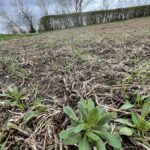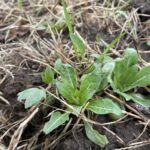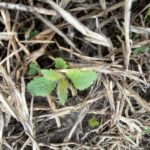Springtime on the Prairie
This spring we anxiously await the emergence of prairie flowers in an area that had been traditional lawn. This is a periodic continuing blog about the process of converting the lawn to a prairie. We’ll have a couple more updates this season. Here’s what we did to prepare for this year’s growth:
2020
April and May 2020: Sustainable Landscape Solutions sprayed the lawn twice to kill existing grass plants, which were nearly entirely exotic species.
May 2020: Sustainable Landscape Solutions tilled the now dead turf.
May 2020: Rich and Marion broadcast a diverse array of seeds that included 82 wildflower species and a few lower-growing types of priaire grasses.
August 2020: A derecho felled three trees west of the site and a few to the east. This increases the sun on the new prairie. That’s good.
By mid-summer, a thick growth of annual crabgrass covered the site with only partridge pea obvious from our seeds.
November 2020: The crabgrass was dead and dry, so we burned it on the same day we burned our existing prairies. The fire was slow and low.
2021
Winter 2020/21: Heavy snow covered the site for much of the winter. When it melted, we discovered mostly bare soil with few surviving exotic grasses present. This is perfect, as native seeds will respond to warm temperatures.
April 2021: Small prairie forbs are emerging. Among the many spring greens poking up, we can identify Black-Eyed Susans, Mountain Mint, and Partridge Pea. Only a few of the 82 species we cast out. Part of the fun of restoring prairie is learning what the emerging plants are.
- Part of the fun of establishing prairies is learning what the plants are.
- Possibly shooting star?
- Poking through
We’ll update with a Prairie Renaissance Blog as the natives get going.




